
|
||
|
Portland art blog + news + exhibition reviews + galleries + contemporary northwest art
|
||
Interview with Inigo Manglano-Ovalle part II Part
I of PORT's interview with Inigo Manglano-Ovalle discussed his shows
Gravity Is a Force to be Reckoned With at Mass MOCA and Happiness
is a state of inertia
at Max Protetch Gallery, in continuation here the conversation digs deeper
into the artist's sources and process.
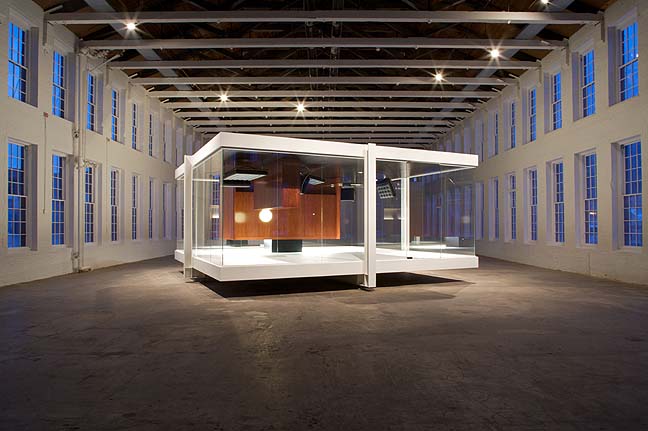 Gravity Is a Force to be Reckoned With, MASS MoCA Alex: Switching gears: How does Sergei Eisenstein's movie Glass House relate to Gravity Is a Force to be Reckoned With at Mass MOCA? Inigo: In the beginning I was interested in uncompleted projects. These uncompleted projects were also located historically in a similar sort of period - these were projects by individuals in a period of modernity. So I was interested in Eisenstein's Glass House because that was the title of what would be his first film in the US. Which was to be based on We (the novel by Zamyatin). I'm really interested in this. Also I'm interested in that when you read We his architecture is very similar to 1924-6 theoretical projects happening in Europe, which Eisenstein would have seen when he went to and had seen when he went to premier The Battleship Potemkin, right? SO when he went to Berlin to view the Potemkin he talked about this architecture-on-paper. And the architecture-on-paper were actually drawings because they were unbuildable projects. One of them certainly would have been Mies' Glass Skyscraper for Friedrichstrasse. So Mies' Glass Skyscraper for Friedrichstrasse could very well be a building in Zamyatin's book "We", right? Mies is not reading Zamyatin and Zamyatin was not necessarily seeing "We", but Eisenstein has both read Zamyatin and is looking at Mies. 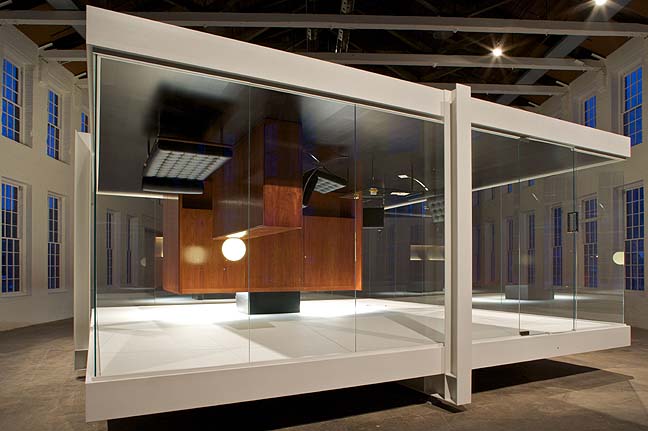 Gravity Is a Force to be Reckoned With, MASS MoCA Then Eisenstein's idea is to make this project called the "Glass house" in Paramount studios and he get contracted for this and actually starts to talk to engineers and movie set people to figure out how to build glass rooms that he can shoot from underneath and so forth. He starts to actually talk about it, then starts to narrate some - making some minor kind of sketches on what his screen play would be, right? Who his protagonist would be. Etc. Next, one of the next that Eisenstein did that I really liked is that in his proto-screenplay his protagonist doesn't necessarily identify himself as the mathematician in We. Eisenstein says you don't know if the character is a mathematician, a priest or a clown, right? And at this moment in some of Eisenstein's notes - he's very sparse on this - he talks about this character getting in to such things that he's banging his head against the glass wall to call attention to people on the other side on the wall, right? Because this literal and physical transparency in We can only exist if one ignores that transparency of the glass walls. In other words the transparency isn't really there for us to see other people but in We it is more for us to be seen by some monitoring device. So it's a very large and fluid panopticon, right. That character tries to break that panopticon and he tries to make the other person see him. That moment in Eisenstein's film that was never made was something I was really intrigued with. And what I had originally wanted to do was to make Eisenstein's film, right. So Gravity Is a Force to be Reckoned With is a collapse of Mies' unfinished project and Eisenstein's unfinished project. And so what happens is that the We… we are Eisenstein's "Glass House" and he says it gets played out in two places. One is through the phone calls, where the protagonist is absent. And the other is with what I call the only way to experience the house is actually "cinematically" right? The way that you move around the house you are basically tracking a shot. You become the camera… so two deflections for Eisenstein's uncompleted project. Would you say that all your work is best viewed in a cinematic mind frame? Only in this sense right? That one of the reasons I'm interested in quoting Eisenstein is that he had also written an essay on architecture. His father was an architect. And he was supposed to go to architecture school but he didn't want to. But Eisenstein wrote about architecture and he was very natural about architecture. Hence when he was in Berlin he went to go see architecture, right. He went to see these theoretical projects. He wrote essays on how architecture works as not as a singular image or object but as an experience. That we need to move through it that architecture unfolds to us as we move through it. This was really important to me early on. 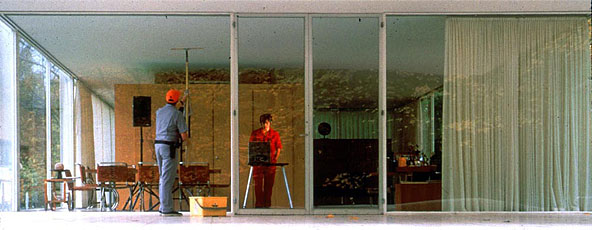 Le Baiser - The Kiss (1999) multi-channel video installation and projection, cd audio recording, and mixed media dimensions variable That essay was actually really important in developing The Kiss or La Blassiare as an installation. It was actually floating in space, right. Where the projection was something that you came to and moved around in and there was no correct space to stand. You could even go inside the building or outside the building. So at that moment I decided it was seminal for me. When I think of the viewer viewing work, how they take in the work, even the kind of criticality and the paradox that occurs in real locations real corporal locations; that's a phenomenological experience. You are standing with this "thing." This "thing" occupies the same space with you and time with you and so it is contrary to conventional cinematic experience. Which for me is a Quarto Centro experience and what I mean by that - in the renaissance you have a perspective painting and the painting is meant to bring everything to a center spot. This is our usual experience with film. So when you go into a movie theater lets say you might come in late and the good seats are gone. And your off to the side maybe too close to the front. But once you sit down in that black box you especially experience the self and some how project yourself to this natural sector. So that is one kind of cinematic experience, that the consumer cinematic experience. And the other is the camera, right. In other words that you actually move through space. Isn't that a mindset though? You can always move around space and acknowledge it, but is there a particular mindset that you engage in? …because there are certain moments where life seems more cinematic than others? Well I guess it depends on the term. Like when you say "there are certain moments where life seems more cinematic," for example and those moments tend to be the ones that are beyond real experience. So you say "this is like a movie." I think I'm more interested in what the cinematic experience tries do. We do it all the time too but we aren't being conscious of it. 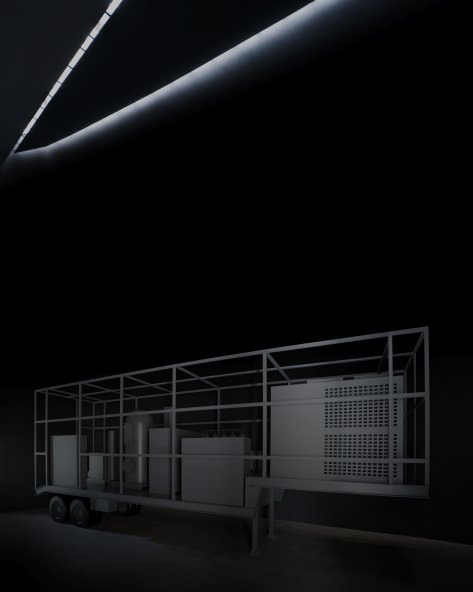 Phantom Truck (2007) 32'9" (10m) long x 8'2" (2.5m) wide x 13' (4m) high project for Documenta 12, Kassel, Germany, 2007 The camera is an apparatus and film making as an apparatus has to actually create a situation into which we can project ourselves into experiencially, but remove all the apparatus so we never see it. We never see the lights, we never see the dolly tracks. The apparatus has to be invisible. Ok? Then what I'm interested in is bringing back the apparatus, but the apparatus is you, you're the apparatus. So in Documenta 12 the hybrid right? You go into a dark room and it takes about 30 seconds for you to even realize something is in there with you and even a little longer for you to realize the scale of it to discern what it might be, right? It might end up to be just be a truck. And that's it - that all you know. You might not know anything else that I've put into it… about Colin Powell, his speech and what not. But if you just get that… that to me is really important. Because what happens there is that you become the apparatus for making this thing visible. And then if you understand what the piece refers to. Then you, in a sense, have become part of the apparatus that has, in a sense, made it appear. You've colluded in the grand lie, you are the mechanism for allowing the lie to produce itself. And it's actually a physical experience, it's not optical, it's physical. It's standing in a space, it takes time and it is not immediate. It's an almost psychological apparatus that we have to engage in. And once again, I am here with this thing and this thing is in this space here with me. It is more of a phenomenological experience than an intellectual experience. Would you say that self similarities appear in your work and if so does your work relate to fractal geometry and/or chaos theory at all? I think that in some of the work I'm definitely pointing towards that. There's a piece of mine called "Vanishing Sky" and its just a mathematical problem that creates universes, always creating universes. Lets call them stars, right. As the universes are being created the program is extinguishing them star by star. So your watching these universes being created and your also watching stars going off. Also it is generated, so there is definitely a notion of that pointing to the basis of evolution… that is version of fractal equations or the notion of the arbitrary. I actually started doing that very early on because I had problems. I had this piece called "Sonambulo" which is a summer rain storm that last 11 minutes. It starts off as a thunderstorm. It's kind of like a new age meditation, 11 minute new age track. But its single source is a gun shot. But then is morphed into all the sounds that you're hearing. And one of the problems was with rain drops. You couldn't create raindrops that sounded like raindrops because every thing would sound like rhythm. So that's the first time back in 1998 that I had to engage a mathematician to help me to create a fractal equation. That would allow the generation of all these thousands upon thousands of rain drops to fall without rhythm and at different distances and different weights with each other. To me it was it was almost like "I need to resolve a technical problem." Later on maybe I'm referring to these things in the work. In here (Max Protetch Gallery) I am definitely referring to it within the photographs. 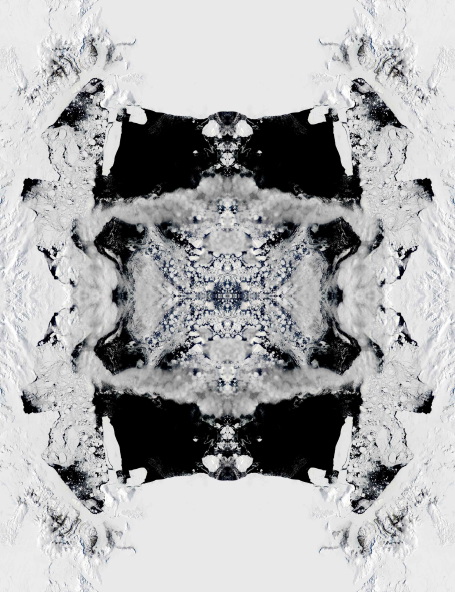 Iceberg B15 (12/18/03 05:20 GMT), 2010 Or the Rorschach inkblots. Or the kaleidoscope, or the fact that we may not know what these photographs are about. And it may be very difficult to understand what they are and where they come from. But there is a sense of familiarity when you look at these photographs because I think culturally we have become really acclimated to the notion of the fractal. And the geometric patterning, which is a very high end math is actually palpable within culture. We see it we use it, we're familiar with it. So although one of the things that these photographs do, or that they want to do at first. Is that they want to present themselves that way. If you come in and see them for the first time it's some psychedelic New Agey image that you are looking at. That's fine, that's what it wants to do, and then maybe later on you locate what the source is and you begin to understand that there is time that shows up in this set of photographs. What inspires you to make art/work? What inspires you to be active? Lately I've been thinking that… it depends on what project I'm working on. But a lot of times I think that part of my activity, I can't label or have a harder time labeling as art. In other words I don't need that thing for myself - {labeling} what I do in the world as art. Sometimes what inspires me the most is that there is something that I have to see for myself. There are questions I have to pose and I have to pose them - for myself. And I don't have to answer them. I just have to pose them. And some of those questions or situations are creating this. And the question is never just purely intellectual, right. It's never purely conceptual in a sense. It is actually situational. You create a situation for an inquiry to exist into something. Some of those inquires are things I want to share. I want other people to experience them. I don't necessary want the situations to answer the questions or to find a correct answer. I try very hard to tell people who may represent my work or what not, "Don't tell them what it is. There is no answer. You don't get it. There isn't something you're suppose to get." You might say where the source is from but the subject of the work is never the source of the getting of the work, right. So I think that what inspires me is… I don't know. Wanting to experience something. Really wanting to experience something. So its foremost for yourself… but what makes the work successful for you? And do you get satisfaction out of every work or is there works that give you more satisfaction than others?  Cloud Prototype No.1 (2003) fiberglass and titanium alloy foil installation view at Max Protetch Gallery, 2003 Certainly there are works that are more successful than other. And certainly you keep making work because its never been truly successful. Successful seems like such a bated word… how about self-satisfaction? Satisfaction… You know its really interesting because successful is very different. You are right. Success if very different. You want work that is very different. You want work that is "working" not that "works." But that is working. Some work works better than others. It is working. The notion of working is a larger concept and so some of it does it better than others. Or you suddenly find something that works and have to go back to it. You pose these intense questions that are in essence unsolvable. I'll relate it back to myself for a second. When I pose intense questions if one person has a particular relationship whether it is "right" or "wrong" I am satisfied. I think when I'm experiencing the work. Because a lot of my work I experience literally the first time when installing it. A lot of the important work for me is work that is special/based on time. Even though it might be a static object or something. There's no way too… your creating a situation. I definitely... I think that I am very good at creating situations but I can't know all of the things that will come froth from those situations, a totality of them. So a lot of the satisfaction comes from surprise, right. When I'm again surprised by something. But also equally and maybe perhaps even more so when somebody experiences the work with me and says something that I had never planned for that I had never realized was in the work but it is totally true. And at that moment there is this incredible rush because I start to realize the work is working. In other words it is generating meaning, right. Yeah. It's not didactic. It's not communicating meaning. In other words its not communicating my meaning to you. But it's generating meaning. That has as its source meaning not everything that I put into it. But another source which is the viewer, another viewer, the other. And that brings it alive. And to me - that's a big rush. There are big questions that I am still trying to ask. The fish tank here I'm grappling with whether I should call it "Bauen." I've been wanting to call it "Bauen" 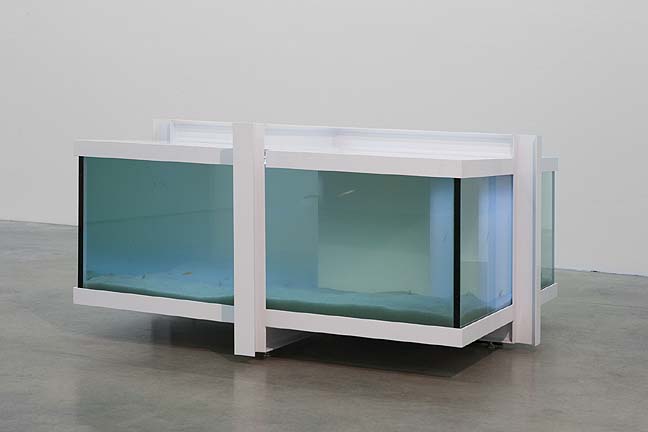 Bauen (2010) aluminum, glass, water and Astyanax fasciatus mexicanus (Blind Mexican Cave Fish) Bauen? B A U E N right? Because its an essay I've read very early on. Very early on, I was very young by Heidegger, on dwelling. So bauen as a word for dwelling. But dwelling also as a verb and building as word for building the building. And the notion of dwelling as a way to contemplate how we exist. Dwelling as a notion of existence. The fact that we can not actually exist or be conscious of existence without dwelling, right. Without actually the notion of dwelling. We are just set out there in a vacuum so we have to construct a habitat. And the habitat isn't physically floors and walls. But we have to construct a habitat. And that as humans we're always constructing habitats or destroying habitats, right. So, I'm rereading that now because of this piece. I'm rereading that and I'm trying to come to grips with whether I 'm dwelling. Or if I'm actually dwelling the right way. Whether we are dwelling the right way. Whether we are consciously building and taking care of what we build the right way. And by "building" here I am not talking about "architecture" which is almost everything. Like… Society… Right. So in this exhibit you have this large global picture, right. This massive expansive land that is imaged. Bodies of water and ice environment are imaged, right. And then you have this small, small ecosystem that's trapped in this piece of architecture. And both are sites of dwelling, right. And one of them is actually an inquiry back to us, back to our selves. Kind of a Rorschach test that tries to analyze our own state of denial, right. That we're not actually recognizing that our dwelling is something bigger and more complicated, and maybe perhaps more essential and more primordial than what we think about our dwelling is, right. What we go about seeking for our dwelling, right. Our house, our apartment, our car, our clothes these are things that we apply to most dwellings. This is how we live, right. How do you live: I have this apartment, I have these records, I have this car, I have these clothes. This are the structures that define how we live. But Heidegger was talking about a different notion of dwelling. And I am asking that with myself. What does that mean right? 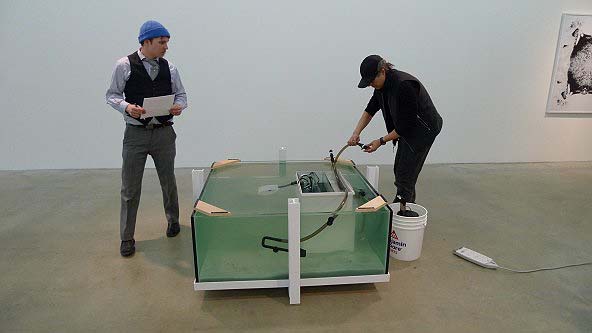 Inigo Manglano-Ovalle installing (right), Alex Rauch (left) Now, for the viewer these are big heavy questions and you have to understand when I'm talking to you… For me and you I think it's this kind of privileged situation. We get to hit these big things. But how does the regular viewer acknowledge this. They just come in. Well I think its very simple in many cases. Like this piece here you just look at this object. It's a dead sort of dumb modernist object. You might as well go over to Zwirner gallery right now and look at the Larry Bell's, McCracken's, Robert Irwin's and all its doing is sort of riffing off those kind of things. Except that moment when you realize that the fish you are looking at are blind. There is in that moment… I have built in a situation in which I am guaranteed and I am guaranteeing that my viewer with just that little bit of knowledge enters into this moment of this kind of existential moment. Because humans will always - blindness for humans, right. I'm not talking about impairment. Just the notion of blindness. We approach it in a very profound sort of way. Because it's a state. It's a state that we can think about but can't necessarily conjure up. And so this is what I mean about that state of existence, right. Its kind of built in. it drives the piece. These are blind fish. For a moment I know they'll be thinking about; there're blind, I'm not blind. Are they going to laugh? They might, you know. On a level it seems like a stripped irony. If you do self reference it. If you don't put blind fish in a clear fish tank… That's lit. These guys should be in the dark. So there all this built in irony, right. Like this cave is fully of light and all the walls are glass so you can't cast a shadow. So vision wouldn't help you gain knowledge this time. Can they feel the heat from the light? Well the lights are very low heat. Do the blind fish just run right into the glass? Sometimes they don't but that one did… I think they're working it out all right. It's interesting, I don't know how they function. Would they do that in a cave? Yeah. They're probably going at this particular speed that they probably know how to function at. I talked to this guy about the cave and says its totally smooth. You have to be really careful walking in these caves because the bottom is so smooth. I mean its undulating. Its so smooth. So they're always hitting smooth surfaces. Hard but smooth. In this they're hitting something at a right angle. I was reading this paper on Happiness Inertia (Happiness Inertia: Analytical Aspects of the Easterlin Paradox) and economics There is this quote "if Happiness Inertia is to be more than a transitory phenomenon, we should be focused on the long run. Further, one interesting case surfaces whereby the most consumption and habit-rich societies are the "least happy" (have the lowest welfare)." Which leads me to the question: Where do wealth and welfare come to an equilibrium? Which I also narrated into this piece as a commentary on global warming. Yeah, this is a commentary on our state of denial and also our ability for escapism and ironically the piece is almost at first a glance denial what they are. And then we read them formally as graphic things and they are kind of escapist. So the Rorschach test is the very thing it is trying to analyze… it's becoming that. The Rorschach test is already a system of denial. 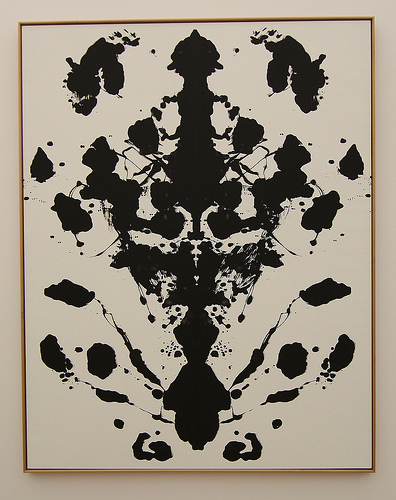 Andy Warhol - Rorschach, 1984 It's a denial of an ink blot? It's a kind of denial. In a way what I'm saying is, because the image by very subtly mirroring itself starts to deny what it is. It flattens itself of what it's actually looking like. It denies what it's looking at and suddenly you are shifting… what was originally the center focus is now the margin. And in the center (of the original picture) is this thing that isn't interesting. Also, there is this denial of what we are looking at, even if just at first glance you can't really tell what they are and then it has that kind of kaleidoscope. It's a kind of psychedelic poster; there's that sense of escapism within that. Good or bad right? Even as a mandala that kind of escapism from reality. Even a spiritual escapism. Which can be seen as good or as a negative a kind of social escapism. Escaping the condition. Not necesarily a positive or negative comment on happiness inertia? I think its a negative in the term that I use. Are you familiar with the term affluenza? Oh yeah. It means you are trying to keep up with the Jones and you can't be happy because your trying to keep up to date. Right. And when I say "happiness is a state of inertia" is kind of like Happiness. Not the happiness that should be a kind of fluid and profound state or joy or bliss or just happiness. But what we think of as happiness is actually stagnant set. I think I'm referring to that obliquely. I don't want to be didactic. And that is an interesting problem for me as an interviewer because that's the one thing I want to do as an interviewer is to get a concrete statement out of you. Even though its agents the idea of the work. But at the same time you have to create some narrative about the piece. The title of the show basically came... Its an interesting side because there another site for work and discourse its: there is an image that we produce for a magazine that we have announced the show and the show at mass moca. Mass Moca has this title Gravity Is a Force to be Reckoned With. And so its on this image. And I start to title this piece in response to the other show. It's almost like there is this moment they wanted to put these big letters up there on the window Happiness is a state of Inertia. I said no, that's not the site. The site of that where that is already exists. it exists in the big ad. In between the two? It exists in the art forum ad. And that's another site. So you can throw up the statement there Gravity Is a Force to be Reckoned With at Mass Moca and Happiness is a state of Inertia at Max Protetch both at the same time. So Gravity Is a Force to be Reckoned With has multiple levels of understanding. Physical gravity which is the gravity of the situation. You know that something is actually serious. That something I've had to wrap around my mind. As a physical force or allegory? Yeah I think it actually comes back to what you talked about you not wanting to talk about success. So happiness here in the title may refer to - do you want a clear answer from me? Yes. I can give you one. Happiness here refers to that... success. Its a state of inertia, a tractor. There's no real movement. It's a falsehood Huh. A falsehood is like a false state of reality. Yeah, it's a false happiness. So you are focusing on the thing that is not making you happy, but something that you think should. Yes, acquisition. 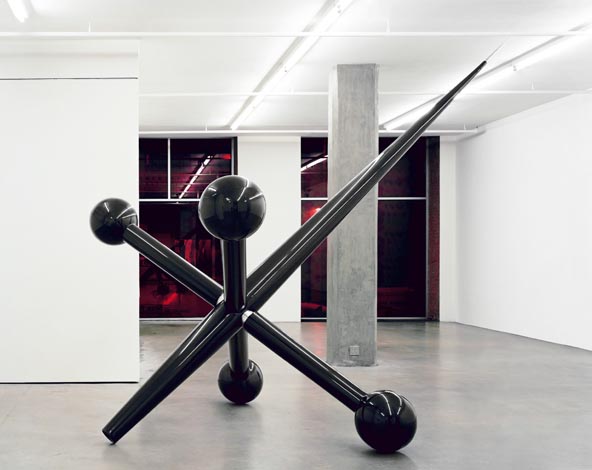 Black Jack (2006) carbon fiber and aluminum That "goal" of that thing you are getting, rather than happiness? So there is this one piece called Black Jack. That was here in this show called Paradise. I was doing these works about Dante's Inferno. So Paradise was part of it was this big sculpture. This is what you get this is what you are. This is your paradise. But of course It is the opposite of an inferno. But here is this glorious object, the weapon, the stealth, the power, the beauty, the blackness, the power. This is your paradise. I think this title has that similar type of irony. I mean that's a child's toy made into a ballistic weapon. Its carbon fiber its totally sexy and beautiful. And then next I thought this is it. I started with purgatory which was the cloud. Which is a cloud but also an explosion. I thought by the time I did this one we were practically into what Bush had created and the state we had arrived in. I just said here, "you are this… is this what you wanted, this is your paradise, this is it." Would you ever be tempted? I mean we're obviously talking it out and you are elaborating on a narrative. As a piece would you ever write out a narrative that would relate to your works? My works? As an overall body. The fractal geometry question I asked earlier on an integral/literal level relates to mathematical things you've used in your work. Which makes me think of self-similarities like a forest. There are patterns to a forest but you can't really see them on the surface. Do you see your work like a forest? That's an interesting question because the other day someone who knows my work came into the gallery and said "this is the el nino effect" this is this thing I've done before. This is the weather systems and warm bodies of water. And yeah there is some sort of... I continue to do some kind of work here there is a hidden pattern but I can't discern it. I can't discern it. And so its not going to be a line. There isn't a thread some sort of progression. And that is the relationship I was wondering about chaos theory and how it might relate within work? Right, from what I understand about chaos. There are two different types of chaos. There is one which is fractal, the non-pattern… it is turbulence. And we're beginning to learn that turbulence has a pattern. You look at it long enough and let it flow there is an actual pattern. Therefore within what we consider chaos there is a kind of stability. And then there is a primordial chaos. And in primordial chaos is this strange situation because in primordial chaos there is actually nothing. Its lack of pattern, its also lack of anything. (Turns and walks toward the latest picture in the timeline of the photographs in Happiness Is a State of Inertia) If anything, here in chaos it wouldn't be the fractal aspect there. We're defining it this way now, right? 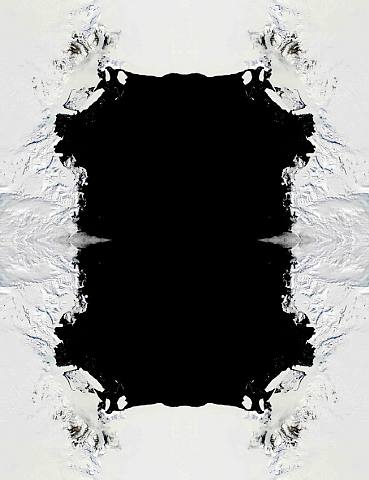 Iceberg B15 (02/15/05 21:55 GMT) 2010 Archival Giclee Prints 26 x 20 inches and 40 x 52 inches Yeah, we're defining it as the void. You know what I mean. The "nothing." Total uncertainty. Total uncertainty. And so chaos has a heavy connotation if your thinking about it philosophically or theologically, but primarily theologically. If you are looking at the midst of creation chaos is very important. De-void the void. Right. And that carries with it a huge weight. And you transfer chaos/chaos theory to then fractals it continues to carry that weight. That term continues to carry that weight. And maybe its actually the opposite. Maybe its not chaos that math is trying to figure out. But that's the beauty in it. When would we know? When will we know? Is there a pattern or is there not? But there is that possibility. You could be a astrologer trying to derive patterns, a Greek astrologer, out of that non-pattern. So you put up your consolations and so you get a pattern to that non-pattern, pitter-patter. And that is one way to deal with chaos. Or you could be a macro-physicist and look at that and look at a nebula. And say that this thing is beautiful. And just think that turbulence is beautiful in and of itself. I don't need to order it. Even though I'm going to try and figure out how turbulence occurs. I don't need to order it. It's the process rather than the answer. And there are two different ways to define the terms. A lot of times I'm more interested in the etymology of the term. Because it ties it to cultural history. And just like when people say to me, "your so interested in science or collaborative science" I'm not interested in science per-se all by itself. I'm interested in science as one of many very complex cultural manifestations. In other words what science produces actually responds to culture. If I believe that the artist doesn't exist solely within their studio, I also don't believe that the most creative brilliant scientists doesn't exist solely within their lab. They are being blemished and tarnished and driven by forces outside. Science, because of politics and the mechanisms of politics, primarily economics, produces what we desire. Like inherent problems that exist within 3-D space that even mathematicians based within theoretically perfect worlds had to acknowledge? A lot of genetic engineering has been driven by the fact that there is a potential consumer out there. If there wasn't a potential consumer out there for what genetic engineering might provide I bet you it wouldn't progress further. So we see cultural in trends. I am interested in that permeation, and that has always been my interest. So I would locate my interest in science being as a part of a cultural engine that isn't driven in isolated spaces. There are actual walls; the walls of the lab and the walls of the art studio are full of holes, permeating. These things are coming in and out. And we're responding. We're never in a isolated hermetic situation. It's impossible. It's uninteresting. Totally uninteresting. The artist who believes himself to be totally hermetic is totally uninteresting to me. In fact I think it's an impossibility. It is an impossibility. Because you are part of a society even if it is a society of one. And if you look at it the fractal is inherent in the title because inertia is a place where chaos would stop, supposedly. Inertia is a place where things would come to a standstill. (laughing) The beauty of this (points to the piece) ... in a way it is very hard. Even though I'm trying on a very simple minded level. Do you feel like there is a point where rhetoric and art jargon is ridiculous? 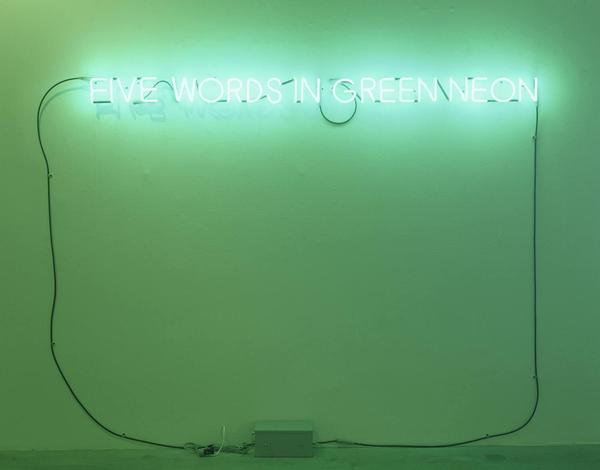 Joseph Kosuth Five Words in Green Neon 1965 Yeah at a certain point. But at another point. Someone asked me when I was doing activist work, "will your work actually change things?" And I go - I learned very quickly that in all the places it can change, in all of those places art can provide real change. Art can actually change power. One of the places where art can change power is language and if someone writes about something or develops a new term or changes the definition of another term because of what art does. Then we're actually making change in language. And language is something that is in the hands of many different elites, but none the less elites. So the place where art can have social/political change might actually be within language. But not within the work. But not within what the work does or what it says by itself. But how it impacts later on in discourse. So yes I have this strange skepticism about art jargon but it is in art jargon where the redefinition takes place. The invention of the term "the other" is huge and has HUGE political impact. And then subsequently the other in that terminology, that way of thinking and its impact on art allowed for the existence of strategies called multiculturalism. Once multiculturalism moved away from the linguistic into a more or less another stylized way of working it lost it's power but it also lost the other. What happened is that we stopped talking about the other. We don't speak about the other. We talk about community. That's a more benign, less incisive, and a less critical term. More innocuous. Right more innocuous, and benign. So you can see that power comes back and recovers itself. But where? In language. Posted by Alex Rauch on March 17, 2010 at 6:46 | Comments (0) Comments Post a comment Thanks for signing in, . Now you can comment. (sign out)
(If you haven't left a comment here before, you may need to be approved by
the site owner before your comment will appear. Until then, it won't appear
on the entry. Thanks for waiting.)
|
| s p o n s o r s |
 |
 |
 |
 |
 |
 |
 |
 |
 |
 |
 |
 |
 |
 |

|
Site Design: Jennifer Armbrust | • | Site Development: Philippe Blanc & Katherine Bovee | |

